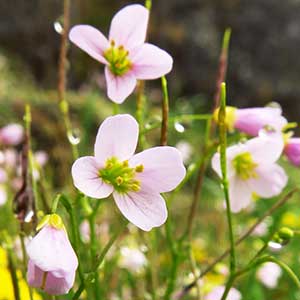Cardamine pattersonii
Cardamine hirsuta
Saddle Mountain bitter-cress
hairy bitter-cress, shotweed
cylindrical, slender, 0.5–1.5 mm diam.
absent.
(simple from base), erect, (not flexuous), unbranched or branched basally, 0.6–3 dm.
erect, ascending, or decumbent, unbranched or branched basally and/or distally, (0.3–)1–3.5(–4.5) dm, (not flexuous).
rosulate or not, 3 or 5-foliolate, 1–6 cm, leaflets petiolulate;
petiole 0.4–2.5 cm;
lateral leaflets similar to terminal, considerably smaller;
terminal leaflet (petiolule 0.1–0.4 cm), blade obovate to orbicular or subcordate, 0.3–1.5(–2.0) cm × 2.5–16(–18) mm, base obtuse to rounded or cordate, margins entire or dentate to slightly sinuately lobed.
(persistent to anthesis), rosulate, (5–)8–15(–22)-foliolate, (2–)3.5–15(–17) cm, leaflets petiolulate;
petiole 0.5–5 cm, (ciliate);
lateral leaflet blade oblong, ovate, obovate, or orbicular, smaller than terminal, margins entire, repand, crenate, or 3-lobed;
terminal leaflet (petiolule 0.2–1 cm), blade reniform or orbicular, 0.4–2 cm × 6–30 mm, margins entire, repand, dentate, or 3 or 5-lobed.
2–4, 3 or 5-foliolate, blade similar to basal, gradually reduced in size as bract, distalmost ones subtending pedicels of flowers (usually simple);
leaflet blade or bract linear to linear-oblanceolate, 0.2–0.8 cm.
1–4(–6), compound as basal, petiolate, [(0.5–)1.2–5.5(–7) cm, including petiole], leaflets petiolulate;
blade base not auriculate;
leaflets similar to basal.
bracteate throughout.
ebracteate.
sepals oblong, (2–)3 × 0.7(–1) mm, lateral pair not saccate basally;
petals purple or pink, obovate, 6–9 × 3–4 mm, (not clawed);
filaments: median pairs 3–3.5 mm, lateral pair 2–2.5 mm;
anthers oblong, 0.7–1 mm.
sepals oblong, 1.5–2.5 × 0.3–0.7 mm, lateral pair not saccate;
petals (sometimes absent) white, spatulate, 2.5–4.5(–5) × 0.5–1.1 mm; (stamens usually 4, lateral pair often absent, rarely 5 or 6);
filaments 1.8–3 mm;
anthers ovate, 0.3–0.5 mm.
divaricate-ascending, (10–)15–30(–45) mm.
erect to ascending, (2–)3–10(–14) mm.
linear, (torulose), 2–3 cm × 1–1.5 mm;
ovules 14–20 per ovary;
style 2–4 mm.
linear, (torulose), (0.9–)1.5–2.5(–2.8) cm × (0.8–)1–1.4 mm, (often appressed to rachis);
ovules 14–40 per ovary;
style 0.1–0.6(–1) mm.
brown, oblong to ovoid, 1.7–2.2 × 1–1.5 mm, (winged distally).
light brown, oblong or subquadrate, 0.9–1.3(–1.5) × 0.6–0.9(–1.1) mm, (narrowly margined).
= 16.
Cardamine pattersonii
Cardamine hirsuta
Of conservation concern.
Cardamine pattersonii is known from Saddle Mountain and Onion Peak in Clastop County.
(Discussion copyrighted by Flora of North America; reprinted with permission.)
Herbarium specimens of Cardamine hirsuta have been misidentified as C. oligosperma.
(Discussion copyrighted by Flora of North America; reprinted with permission.)
- Local floras:
BC,
CA,
OR,
WA
- Local Web sites:
CalFlora,
CalPhotos,
Flora NW,
Go Botany,
IL Wildflowers,
LA Plants,
MD Biodiversity,
MI Flora,
MO Plants,
PNW Herbaria,
Turner Photog.
WildflowerSearch
iNaturalist (observations)
USDA Plants Database
- LBJ Wildflower Center
- SEINet
- Plants of the World Online
- Encyclopedia of Life
- Wikipedia
- Google Image Search


